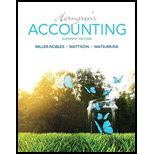
Concept explainers
Concept Introduction
Activity Based Costing: It is a costing method in accounting in which a company (manufacturing company) identifies its manufacturing activities and assigns the indirect
Manufacturing
Predetermined Overhead Allocation Rate: A predetermined overhead allocation rate is used to assign the indirect manufacturing overhead costs to the units of production. It is computed by dividing the estimated overhead cost by an estimated quantity of allocation base.
Allocation Base: An allocation base is used to allocate the indirect overhead costs. For example: Direct labor hours, machine hours, direct labor cost etc.
1.
To Compute: The predetermined overhead allocation rate for each activity.
2.
To Compute: The expected (or allocated) indirect manufacturing cost of each bumper.
Trending nowThis is a popular solution!

Chapter 24 Solutions
Horngren's Accounting (11th Edition)
- I need guidance on solving this financial accounting problem with appropriate financial standards.arrow_forwardCould you help me solve this financial accounting question using appropriate calculation techniques?arrow_forwardCan you solve this financial accounting problem using appropriate financial principles?arrow_forward

 AccountingAccountingISBN:9781337272094Author:WARREN, Carl S., Reeve, James M., Duchac, Jonathan E.Publisher:Cengage Learning,
AccountingAccountingISBN:9781337272094Author:WARREN, Carl S., Reeve, James M., Duchac, Jonathan E.Publisher:Cengage Learning, Accounting Information SystemsAccountingISBN:9781337619202Author:Hall, James A.Publisher:Cengage Learning,
Accounting Information SystemsAccountingISBN:9781337619202Author:Hall, James A.Publisher:Cengage Learning, Horngren's Cost Accounting: A Managerial Emphasis...AccountingISBN:9780134475585Author:Srikant M. Datar, Madhav V. RajanPublisher:PEARSON
Horngren's Cost Accounting: A Managerial Emphasis...AccountingISBN:9780134475585Author:Srikant M. Datar, Madhav V. RajanPublisher:PEARSON Intermediate AccountingAccountingISBN:9781259722660Author:J. David Spiceland, Mark W. Nelson, Wayne M ThomasPublisher:McGraw-Hill Education
Intermediate AccountingAccountingISBN:9781259722660Author:J. David Spiceland, Mark W. Nelson, Wayne M ThomasPublisher:McGraw-Hill Education Financial and Managerial AccountingAccountingISBN:9781259726705Author:John J Wild, Ken W. Shaw, Barbara Chiappetta Fundamental Accounting PrinciplesPublisher:McGraw-Hill Education
Financial and Managerial AccountingAccountingISBN:9781259726705Author:John J Wild, Ken W. Shaw, Barbara Chiappetta Fundamental Accounting PrinciplesPublisher:McGraw-Hill Education





